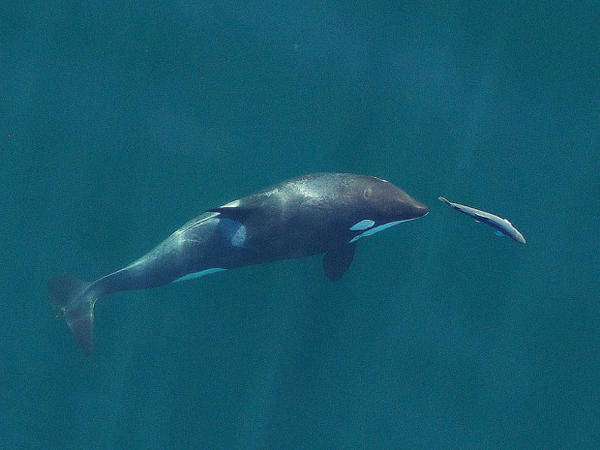Citing a declining Southern resident orca population, the National Oceanic and Atmospheric Administration is requesting collaboration with the Pacific Fishery Management Council, the governing body that creates fishing season regulations from California to Washington.
“We are taking many actions to conserve and recover Southern resident killer whales and particularly to address the three main threats, … prey limitation; vessel traffic and noise; and chemical contaminants. Chinook salmon, the whales’ primary prey, are important to SRKW survival and recovery,” NOAA regional director Barry Thom wrote in a letter dated March 6, addressed to Phil Anderson, chair of the council.
The Southern residents — which frequent the San Juan Islands and consist of three familial groups known as J, K and L pod — were listed as endangered in 2005. Since being listed, the population has gone from 87 individual animals to the current historic low of 74.
In the letter Thom explained that fisheries can reduce prey availability to the whales, which may interfere feeding, “Insufficient prey can impact their energetics; causing them to search more for fewer prey, health; decreasing their body condition and reproduction; reducing fecundity and calf survival.”
It was also mentioned in the letter that in 2009, under the Endangered Species Act, NOAA, and its enforcement arm, National Marine Fisheries, stepped in to analyze the effects of the council’s fishing regulations. At that time, it was determined there was no impact, and the consultation was considered complete. Due to new information, according to the letter, NOAA is re-initiating the ESA consultation.
The council has not responded to the letter yet, according to NOAA affiliate Robin Ehlke, who serves on the council’s salmon advisory workgroup, because the letter was sent on the first day of the fishery management’s meeting in Victoria, British Columbia.
That meeting lasted six days, during which time the organization created the draft alternative regulations for the 2019 fishing season. By fish, that means everything from rockfish groundfish and migratory fish like salmon. Ehlke explained that, similar to an environmental impact statement, the group creates three options regulating the range of seasons geographically, as well as identify user groups and designate their catch limits, in March. To see the current drafts, visit https://www.pcouncil.org/2019/03/57934/council-releases-alternatives-for-2019-west-coast-ocean-salmon-fisheries. These proposed alternatives will be open to public comment in April. After citizen input, the council then chooses the preferred alternative, with some tweaks if necessary.
While no plan for a partnership has yet been discussed between the two agencies, Ehlke said she envisions working closely with NMFS and NOAA to determine impacts of fishing and create an action plan if needed. Ehlke added that she would not be surprised if the partnership continued beyond the short term, past the April meeting. Whether that is in the form of a panel, or a more loosely organized working group and whether that team consists of representatives from fisheries agencies or NMFS and the council is currently up in the air.
Regardless, Ehlke noted, it has been helpful that NMFS provided the council with the results from decades of research on the Southern residents, particularly in regards to their diet and biological requirements. That data will help the council focus in on addressing those specific salmon types. Now that the March session has wrapped up, Ehlke said, she will be pouring over the data that NMFS provided regarding the metabolic needs of the orcas.
“I am really interested in working through the data and seeing how everyone can work toward protecting both the orcas and salmon,” she said.
NOAA said it is creating a risk assessment that comprehensively analyzes the effects of salmon fisheries on the whales and their prey, flagging lower Columbia River, Sacramento River and Klamath River fall-run Chinook salmon stocks as critical for the endangered whales.
One factor threatening salmon, Ehlke noted, are poor ocean conditions. The warmer water that has been occurring along the Pacific Coast over the last several years has been harmful to salmon, especially the young fish heading out to sea. These animals thrive on cooler water temperatures where their food is more prevalent and disease less likely to take hold.
The council, Ehlke added, will look at all aspects impacting both salmon and whales, and fishery managers need to look at and get a better understanding of how they are impacting the whales and their metabolic needs.
“These animals are important, to everyone and to us,” Ehlke said. “We are going to be working closely with NMFS and NOAA to come up with a plan that is beneficial for both the orcas and the fish.”
To read the letter in full, visit https://www.pcouncil.org/wp-content/uploads/2019/03/D1a_Supp_NMFS_Rpt4_SRKW-Guid_MAR2019BB.pdf.
For more information about Pacific Fishery Management visit https://www.pcouncil.org.



